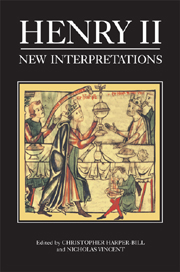Book contents
- Frontmatter
- Contents
- List of Illustrations
- Editor's Preface
- List of Abbreviations
- Introduction: Henry II and the Historians
- The Accession of Henry II
- Henry II and Louis VII
- Doing Homage to the King of France
- Henry, Duke of the Normans (1149/50–1189)
- Henry II and England's Insular Neighbours
- Henry II, the English Church and the Papacy, 1154–76
- On the Instruction of a Prince: The Upbringing of Henry, the Young King
- Henry II and the Creation of the English Common Law
- Finance and the Economy in the Reign of Henry II
- Henry II and the English Coinage
- The Court of Henry II
- Literary Culture at the Court of Henry II
- Henry II and Arthurian Legend
- Index
Introduction: Henry II and the Historians
Published online by Cambridge University Press: 12 September 2012
- Frontmatter
- Contents
- List of Illustrations
- Editor's Preface
- List of Abbreviations
- Introduction: Henry II and the Historians
- The Accession of Henry II
- Henry II and Louis VII
- Doing Homage to the King of France
- Henry, Duke of the Normans (1149/50–1189)
- Henry II and England's Insular Neighbours
- Henry II, the English Church and the Papacy, 1154–76
- On the Instruction of a Prince: The Upbringing of Henry, the Young King
- Henry II and the Creation of the English Common Law
- Finance and the Economy in the Reign of Henry II
- Henry II and the English Coinage
- The Court of Henry II
- Literary Culture at the Court of Henry II
- Henry II and Arthurian Legend
- Index
Summary
Some eight hundred and fifty years ago, a red-haired and fiercely energetic young man succeeded to the throne of England as King Henry II. Descended on his mother's side from the Norman kings who had ruled England since 1066, and on his father's from the Plantagenet dynasty that had held sway over Angers and the Loire valley from at least the tenth century, Henry II was vastly to extend this ancestral inheritance. By his marriage to Eleanor of Aquitaine, he had already acquired dominion over the whole of south-western France, stretching from the Loire down to the Pyrenees. Through a process of political coercion, by the mid 1160s he was to project his authority westwards into Brittany and Wales and northwards to reseize the counties of Westmorland, Cumberland and Northumberland occupied for the previous twenty years by the kings of Scotland. In 1171, stepping into the maelstrom caused by Richard Strongbow's conquest of Leinster, he led an expedition that was to claim Ireland and its lordship for the English Crown. Three years later, victorious in a civil war fought out against his eldest son, he obtained the right to establish English garrisons at Berwick, Edinburgh and as far north as Stirling, imposing oaths of homage upon the Scottish king. His military exploits, his political cunning and his courtly magnificence had already brought him and his family alliances with the rulers of Spain and Saxony and with the Capetian kings of France, and in due course the youngest of his daughters was to be married to the King of Sicily.
- Type
- Chapter
- Information
- Henry IINew Interpretations, pp. 1 - 23Publisher: Boydell & BrewerPrint publication year: 2007



